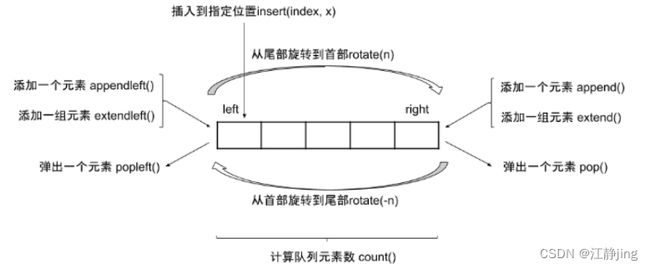蓝桥杯考前必看知识点【python 代码详解】
文章目录
- 前言
- 一、基本知识点
-
- 1.基本输入输出
- 2.列表转字符串
- 3.字符串大小写转换
- 4.匿名函数lambda
- 5.二/八/十六进制
- 6.chr/ord转换
- 7.保留小数点后几位
- 8.排序
- 二、python常用内置库模块
-
- 1.factorial阶乘
- 2.Counter计数器
- 3.defaultdict默认字典
- 4.deque双向队列
- 5.permutation全排列
- 6.combinations组合
- 7.accumulate累加
- 8.heapq堆
- 9.datetime时间
- 三、常用算法模板
-
- 1.最大公约数 / 最小公倍数
- 2.质数判断 / 质数个数
- 3.快速幂
- 4.bisect二分
- 总结
前言
最近一直在准备蓝桥杯,看了很多知识点及模板,考前几天就来个总结笔记巩固一下吧。写的还是比较全面的,希望也能帮助到其他备考的小伙伴呀>_<。
一、基本知识点
1.基本输入输出
s = input() # 一个字符串
n = int(input()) # 单个数
a, b, c = map(int, input().split()) # 多个数
l_1 = list(map(int, input().split())) # 整个列表(空格分隔)
l_2 = [int(i) for i in input().split()] # 整个列表(空格分隔,和上一个差不多)
print(s, n, a, b, c)
print(l_1, l_2)
"""
输入如下:
abc
10
1 2 3
4 5 6
1 2 3 5 6
输出如下:
abc 10 1 2 3
[4, 5, 6] [1, 2, 3, 5, 6]
"""
2.列表转字符串
l_3 = ['a', 'b', 'c']
print(''.join(l_3)) # 输出结果:abc
3.字符串大小写转换
a = "abcd"
b = "ABCD"
print(a.upper(), b.lower()) # ABCD abcd
print(a, b) # abcd ABCD
4.匿名函数lambda
lambda的“:”左边是输入右边是输出,尤其和排序函数放在一起真的很好用啊!
def square(a):
return a ** 2
print(list(map(square, [1, 2, 3]))) # [1, 4, 9]
print(list(map(lambda x: x ** 2, [1, 2, 3]))) # [1, 4, 9]
h = [[2, 4],
[8, 9],
[4, 5],
[5, 10]]
print(sorted(h, key=lambda x: x[0], reverse=True)) # 按照每个列表的第一个元素倒序排序
# [[8, 9], [5, 10], [4, 5], [2, 4]]
5.二/八/十六进制
print(hex(17), oct(9), bin(3)) # 0x11 0o11 0b11
print(int('11', 2), int('11', 8), int('11', 16)) # 3 9 17
6.chr/ord转换
ord()就是得到字符的ASCII值,chr()是通过ASCII值找到字符。
print(chr(97), ord('a')) # a 97
7.保留小数点后几位
整理了三种方法如下:
x = 1.321
print(round(x, 2)) # 1.32
print('%.2f' % x) # 1.32
print('{:.2f}'.format(x), f'{x:.2f}') # 1.32 1.32
8.排序
- nums.sort():在原列表上直接排序
- sorted(nums):不改动原列表,生成新列表
nums = [5, 2, 7, 1, 3]
nums1 = sorted(nums, reverse=True) # 倒序
print(nums1) # [7, 5, 3, 2, 1]
nums.sort()
print(nums) # [1, 2, 3, 5, 7]
二、python常用内置库模块
1.factorial阶乘
可以使用factorial阶乘求排列组合的结果(不要忘了import math):
def c(m, n): # 是在m个数中取出n个
return math.factorial(m) // (math.factorial(n) * math.factorial(m-n))
print(c(5, 2)) # 10
print(math.factorial(5)) # 120
2.Counter计数器
使用计数器可以直接算出每个元素出现的次数,就不需要我们遍历啦。需要获得列表的话,直接在前面套一个list()就可以了。
from collections import Counter
l2 = ['a', 'b', 'b', 'c', 'c', 'c']
d1 = Counter(l2)
print(d1) # 输出结果:Counter({'c': 3, 'b': 2, 'a': 1})
d1['d'] = 1 # 加一个键值对
print(d1) # 输出结果:Counter({'c': 3, 'b': 2, 'a': 1, 'd': 1})
print(list(d1)) # 输出结果:['a', 'b', 'c', 'd']
print(d1.keys()) # dict_keys(['a', 'b', 'c', 'd'])
print(d1.values()) # dict_values([1, 2, 3, 1])
print(d1.items()) # dict_items([('a', 1), ('b', 2), ('c', 3), ('d', 1)])
3.defaultdict默认字典
我们用哈希表计数的时候,若当前元素不存在,则置为1;但是用defaultdict直接+1就行,不需要判断,因为创建defaultdict的时候已经规定了默认值类型。
from collections import defaultdict
d2 = defaultdict(int) # 默认是int型,就默认值为0
for i, x in enumerate(l2):
d2[x] += 1 # 省去一步判断存在的情况
print(list(d2.items())) # [('a', 1), ('b', 2), ('c', 3)]
print(d2['a'], d2['d']) # 1 0
4.deque双向队列
from collections import deque
d3 = deque([1, 2, 3], maxlen=4) # 初始化一个最大长度为maxlen的队列
d3.append(4)
print(d3) # deque([1, 2, 3, 4], maxlen=4)
d4 = deque() # 初始化一个无固定长度的队列
d4.append(1) # 添加元素到队尾
d4.append(2)
d4.append(3)
d4.appendleft(0) # 添加元素到队首
print(d4, list(d4)) # deque([0, 1, 2, 3]) [0, 1, 2, 3]
print(d4.popleft(), d4.pop()) # 弹出队首/队尾元素 0 3
print(d4) # deque([1, 2])
5.permutation全排列
from itertools import permutations
l1 = list(permutations([1, 2, 3]))
print(l1) # [(1, 2, 3), (1, 3, 2), (2, 1, 3), (2, 3, 1), (3, 1, 2), (3, 2, 1)]
6.combinations组合
from itertools import combinations
l3 = list(combinations([1, 2, 3], 2)) # 第二个参数为选择组合的个数
print(l3) # [(1, 2), (1, 3), (2, 3)]
7.accumulate累加
accumulate在求前缀和时很好用,不需要自己遍历一遍数组了。
accumulate函数创建一个迭代器,返回累积汇总值或其他双目运算函数的累积结果值(通过可选的 func 参数指定)。如果提供了 func,它应当为带有两个参数的函数但是,如果提供了关键字参数 initial,则累加会以 initial值开始,这样输出就比输入的可迭代对象多一个元素。
from itertools import accumulate
a = [1, 2, 3, 4]
print(list(accumulate(a))) # [1, 3, 6, 10]
print(list(accumulate(a, initial=0))) # [0, 1, 3, 6, 10]
print(list(accumulate(a, initial=1))) # [1, 2, 4, 7, 11]
8.heapq堆
python中的堆是小顶堆,如果是二维列表,默认以每个列表的第一个元素来排序。
1)heapify让列表具有堆的特征;
2)heappop弹出最小的元素(总是位于索引0处);
3)heappush用于在堆中添加一个元素;
4)从堆中弹出最小的元素,再压入一个新元素。
from heapq import *
h = [[2, 4],
[8, 9],
[4, 5],
[5, 10]]
heapify(h)
print(h) # [[2, 4], [5, 10], [4, 5], [8, 9]]
print(heappop(h)) # [2, 4]
print(h) # [[4, 5], [5, 10], [8, 9]]
heappush(h, [1, 2])
print(h) # [[1, 2], [4, 5], [8, 9], [5, 10]]
heapreplace(h, [3, 2])
print(h) # [[3, 2], [4, 5], [8, 9], [5, 10]]
print(heappop(h)) # [3, 2]
9.datetime时间
差点忘了这个,时间模块之前也是经常考的。
from datetime import *
start = date(year=2023, month=4, day=4)
end = date(year=2023, month=4, day=8)
t = timedelta(days=1)
while start <= end:
print(start, start.weekday()) # 0-6 代表周一到周日
start += t
print(end.year, end.month, end.day)
"""
2023-04-04 1
2023-04-05 2
2023-04-06 3
2023-04-07 4
2023-04-08 5
2023 4 8
"""
三、常用算法模板
1.最大公约数 / 最小公倍数
最大公约数在math中可以写,也可以直接使用math.gcd(x, y)调用,调用的时候不要忘了import math :
import math
def gcd(n1, n2): # 自己写
if n2 > n1:
n1, n2 = n2, n1
while n2:
n1, n2 = n2, n1 % n2
print(n1, n2)
return n1
# return math.gcd(n1, n2) if n2 > 0 else n1 # 调用
# print(gcd(6, 81))
最小公倍数就是两数乘积再除以最大公约数:
def lcm(n1, n2):
return n1 * n2 // gcd(n1, n2)
# return n1 * n2 // math.gcd(n1, n2)
# print(lcm(6, 81))
2.质数判断 / 质数个数
判断数n是否为质数:
def isPrim(n):
if n < 2:
return False
for i in range(2, int(n ** 0.5) + 1):
if n % i == 0:
return False
return True
# print(isPrim(7))
判断1到n之间(不包括n这个数)有多少个素数(厄拉多塞筛法):
def countPrim(n):
count = 0
signs = [True] * n # 先假设全为质数
for i in range(2, n):
if signs[i]:
count += 1
for j in range(i+i, n, i): # 质数的倍数一定不是质数,置为False
signs[j] = False
return count
# print(countPrim(5)) # 2 3
3.快速幂
参考了一位大佬的文章,想深入了解戳这里哦,一步一步带你去理解,真的写的非常非常好!
def normalPower(base, power):
result = 1
while power:
if power % 2 == 1:
result = result * base % 1000
base = base * base % 1000
power //= 2
return result
# print(normalPower(2, 1000000000))
4.bisect二分
其实这一部分也可以放在上面内置模块部分。二分法当然可以自己写的,但是现成的库是真好用啊,做题时省时省力!
1)查找:
bisect:查找目标元素右侧插入点
bisect_left:查找目标元素左侧插入点
bisect_right:查找目标元素右侧插入点
2)插入:
insort:查找目标元素右侧插入点,并保序地插入元素
insort_left: 查找目标元素左侧插入点,并保序地插入元素
insort_right:查找目标元素右侧插入点,并保序地插入元素
from bisect import *
l4 = [1, 2, 3, 3, 3, 4, 5]
pos = bisect(l4, 3) # 只查找,不改变列表
pos_left = bisect_left(l4, 3)
pos_right = bisect_right(l4, 3)
print(pos, pos_left, pos_right) # 5 2 5
insort(l4, 4.5)
print(l4) # [1, 2, 3, 3, 3, 4, 4.5, 5]
insort(l4, 2.5)
print(l4) # [1, 2, 2.5, 3, 3, 3, 4, 4.5, 5]
总结
好啦,今天就暂时到这里了,要是再想起什么我会继续补充的。如果大家发现有不妥之处或者有想补充的,欢迎留言哦。
